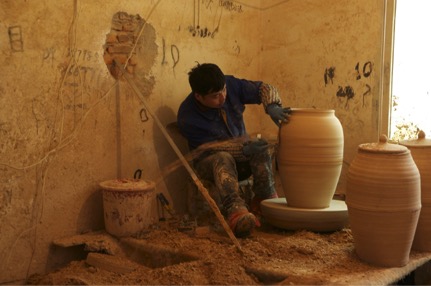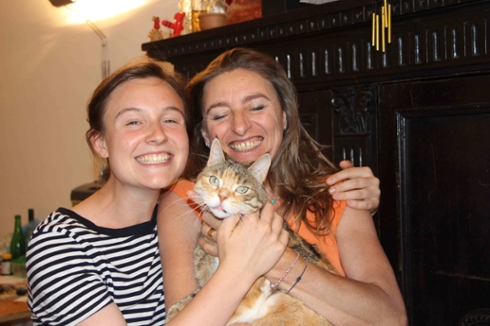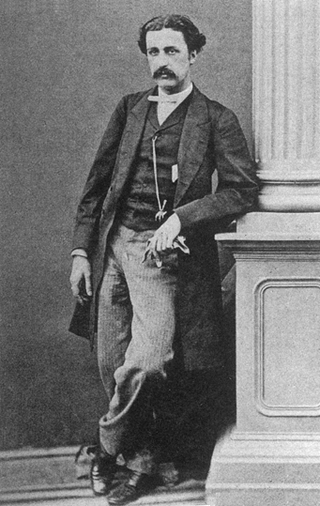Tags
"history"
Living in Clay Time In Clay Town: Kammy Chiu, Winter Fellowship for International Travel

Kammy Chiu, sophomore Economics-ENV major and recipient of the Winter Fellowship for International Travel, reflects on her residency program with The Pottery Workshop in Jingdezhen, China, learning to work with porcelain.
The Pottery Workshop
My artistic residency with The Pottery Workshop (TPW) took place in The Sculpture Factory (TSF), Jingdezhen. For just over three weeks, I thought about absolutely nothing apart from clay. Three other international residents accompanied me during my time at TPW: Edith, an Israeli artist who specializes in painting porcelain tiles, Alberto, arguably one of the most knowledgeable mold-makers in the US who’s about to finish his MFA at Syracuse University, and Josh, another Reedie who introduced me to ceramics a year and a half ago.
Continue reading Living in Clay Time In Clay Town: Kammy Chiu, Winter Fellowship for International Travel
Presidents Summer Fellowship 2015: Haley Tilt, Visual Memory and Livy, Part 3
Haley Tilt, '16, Classics, is adventuring in Rome, tracing and chronicling the geography described by the ancient historian Livy. She plans to create a virtual, interactive map of ancient Rome, based on Livy's depictions.
The last couple of months have seen me ceaselessly behind my computer, tapping away at my keyboard (and more often, my delete key). Working in combination with the SDS was decidedly a good idea. It gave me access to support I couldn't have done without and a group of other folks equally confused as I. Working in combination with others held me accountable for explaining my ideas, for slowing down and dedicating time to decision making, and it allowed me to bounce a quick--or significant--question off someone else. Strangest thing of all, after two months, I am able to answer other peoples’ questions.
And I am able to build a website. It hasn’t been released yet, and probably won’t be until it’s endured a bit more tinkering, but Livy doesn’t come up on the Hum 110 syllabus until Spring, and I have a few more features I want to add. Things moved more slowly than I anticipated, and I learned that web development is actually rather difficult, a good deal more difficult than I anticipated. Just to give an idea of the breadth of concepts I had to explore: there was SQLITE, the language I used to talk to the database containing all of my images, notes, textual selections, etc., there was python coding, to build the web server, there was HTML/CSS, to build individual web pages and style them, and there were javascript and jquery, to handle all of the ‘interactive’ elements of the site. Although I had some experience with python and javascript, everything else was completely new to me, and connecting all of the pieces, passing packets of information between components and learning to unpack those packets at their final destination, was hard. Some of the features whose implementation I thought would be trivial were actually beyond the scope of my current skill-set, so in addition to learning how to develop my project, I also had to learn to think in stages. This particular instantiation of the project will allow people to view a map side-by-side with the selection of Livy’s text that is relevant to the location they have clicked, and to view images of that location today. As I move forward with the project, I want users to be able to do side-by-side comparisons between modern images of sites and reconstructions of those sites, and I want to bolster the research I’ve already done to better document how each of the sites Livy discusses have come to look the way they do today.
Presidents Summer Fellowship 2015: Haley Tilt, Visual Memory and Livy, Part 2

Haley Tilt, '16, Classics, is adventuring in Rome, tracing and chronicling the geography described by the ancient historian Livy. She plans to create a virtual, interactive map of ancient Rome, based on Livy's depictions.
My last weeks in Rome were glorious. Finally comfortable with the city, I decided it was time to venture out into the other, more remote places Livy discusses. One of these places was the town of Veio, forty minutes North of Rome by car, two or more hours by bus.
On the rolling hills above Veio sleep the remains of Veii, the jewel of ancient Etruscan cities. Now a national park, Veii offers little to a casual tourist group. Once immense, the only area of the city now accessible to visitors is a reconstruction of a temple complex dedicated to Apollo. It’s beautiful, but not what I’m looking for. I’m searching for the cittadella, the citadel of Veii, and the seat of the symbolic power Veii held for Livy. The maps I’m accustomed to in US parks never manifest, so I’m left asking the few locals walking their dogs if they know what I’m looking for. No, they tell me, they don’t know where the cittadella is. Finally I find a woman sitting beside a waterfall, and when I ask her my question, she responds to me in perfect English, peppered with a funny combination of Italian and British sounds. Yes, she knows where it is, and she gives me detailed directions, which I will later botch completely, wandering through the hidden parts of the park. She even knows a version of Veii’s defeat by Rome, decidedly different from the version in Livy.
Research: Pictures Big and Small, President's Summer Fellowship Final Reflection, John Young
There is something deeply rewarding about setting up a plan and then executing it. Thought the “heist” metaphor was perhaps a stretch, and though I would never want to implicate myself or my colleagues in “theft” (--though, my brief walk through the British Museum suggested to me that historians, archeologists, and anthropologists have perhaps done their fare share of that, under different names--), finding what I was looking for where I looked for it was a satisfying experience.
What was I looking for? And what did I find? I was looking for the correspondence of Robert Swinhoe relating to Natural History. His “day job” as it were was as a diplomat in the British Foreign Service, and he produced volumes of material related to his work in the consulate. I wasn’t incredibly interested in all of that work, however, and I wasn’t sure what, if anything, I would find in his diplomatic writings with respect to his natural historical work. I did manage to locate all of his archived diplomatic writing. The day after arriving in London I went to the National Archives and spent the morning and afternoon browsing microfilmed catalogues of Foreign Service Office material, looking for things that Swinhoe produced. I spent the whole of Saturday and Sunday at the National Archives—it was the only one open over the weekend.
I had planned to do the archival work here over my first weekend because, although of lesser importance to my overall research interests, it would give me the opportunity to “practice” doing the work of a historical researcher.
Continue reading Research: Pictures Big and Small, President's Summer Fellowship Final Reflection, John Young
Phase 1

Robert Swinhoe
John Young '15, environmental sciences/history, was awarded a President's Summer Fellowship to "travel to and collect consular records from the British National Archives, the Royal Geographical Society, and the Natural History Museum in London, and then return to Reed in order to analyze and further chart the collecting habits and practice of natural history of the ornithologist Robert Swinhoe (1836-1877)."
Professor Douglas Fix tells me that one should have an excellent idea of what collections an archive holds long before one arrives at the archive’s reading room. A visit to collect documents, a perhaps seemingly pedestrian task, requires a large measure of pre-visit prep work.
More than I anticipated.
Continue reading Phase 1
Locating the Past: Language and Culture in BNF Manuscript 375, Presidents Summer Fellowship
For my President's Summer Fellowship Award, I undertook to pinpoint the geographical origins of a medieval French manuscript and to thereby develop a novel philological method of inquiry that could hold great promise for medievalism, art history, and for my development as an individual and a scholar.
